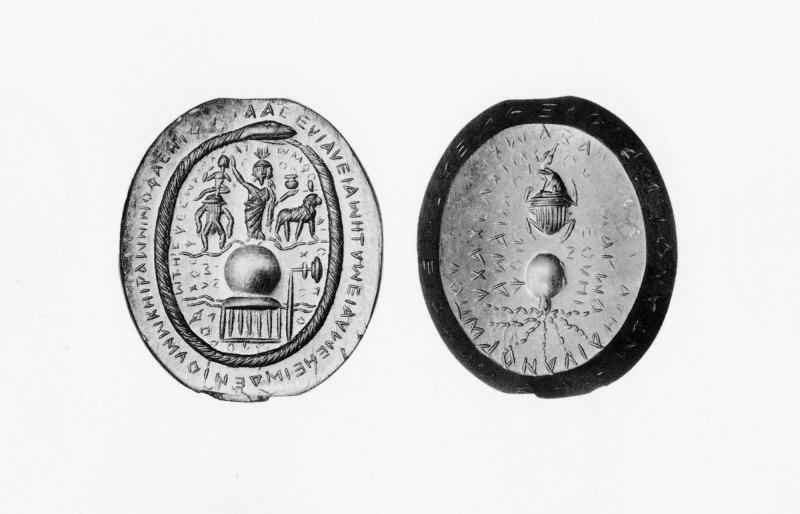 Bonner, SMA – PDF, 90.
Bonner, SMA – PDF, 90.
On a few uterine amulets the stylization of the organ has taken a turn that differs not a little from the predominating potlike type. In my collection there is a specimen, unique in my experience, which is made of metal, apparently iron with a slight admixture of zinc. The design on the obverse not remarkable. Over the vessel stands a female figure without distinguishing attributes, probably Isis; at the left, and considerably below her, stands the deformed Bes; at the right, behind Isis, a quadruped apparently meant for a lion.49 Several of the vowels are in the field, but the sequence is not complete. The design is surrounded as usual by the ouroboros. On the reverse, above, there is a scarabaeus beetle, below, an ovoid object from the bottom of which several wavy lines extend. The effect is rather like a conventionalized octopus. An inscription of some length encircles the field almost twice, but because of the wearing away of the metal and the confusion caused by adventitious scratches and stains, some parts are illegible. It contained the name Ororiouth followed by an aberrant form of the Sthombaule formula, which is usually associated with the solar divinities; see Chapter XIV. The same octopuslike treatment of the uterine symbol, again coupled with the scarabaeus, is to be seen on the reverse of a remarkable red jasper in the British Museum which I believe to be a birth amulet, and which must be discussed in detail a little later.50 It is also well illustrated by the amulet belonging to the Fouquet collection, which Barry published with inadequate comment.51 He described the octopuslike symbol as a solar disk from which four serpents are emerging below.
This way of representing the uterine symbol is of special importance bemuse it helps to explain the strange Byzantine development of the same object into a center representing a human face, from which serpents radiate in every direction, their heads at the circumference of the wheel-like design. The effect is that of a crudely executed Medusa; but it is almost certainly derived from the “octopus” version of the uterine symbol. Several examples of this Medusa design are known; since they have been treated by various scholars it suffices to refer to their writings.52 All the known specimens seem to be of medieval Byzantine workmanship, and most if not all of them are inscribed with a charm, complete or abbreviated, which is addressed to the ὑστέρα and has for its purpose the assuaging of pains or diseases affecting it. A curious feature of the incantation is that represents the organ as an angry, restless beast whose rage must be quieted by the magical spell.
This notion of the womb as a thing having a life of its own, and moving
49 Compare the somewhat similar gem in Athens, published by Delatte, Musée Belge, 18, 75, No. 33, Pl. 3, No. 10.
50 B. M. 56389 (D. 145). Compare also B.M. 48024, which has above the uterine symbol Harpocrates seated on the head of Bes, also Isis, and a lion; on the reverse, an eagle-headed scarab beetle and below it an “octopus."
51 Ann. du serv., 7, Pl. 2 A.
52 The best treatment of these amulets is that by W. Drexler, Philol., 58 (1899), 594–608; see also W. Froehner, Philol., Suppl. Bd., 5, 42–44; Schlumberger, REG 5 (1892), 89–02. Illustrations will be found in Chiflet, Pl. 17, 70; Montfaucon, II, 2, Pl. 169; Kopp, Pal. Crit., IV, 330–331; King, Gnostics, p. 20, fig. 1; p. 57, fig. 3.
Cf. Dasen 2019, comm. ad Bonner, SMA 79–94

